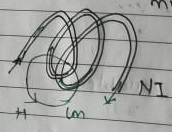CONSTRUCTION OF THE TRANSFORMER
Transformer
has two wingdings, made of insulated copper, enameled is used as insulation.
Windings are supported of core, which is made of iron. One winding is connected
to supply, defined as primary winding and one winding connected to the load or
not connected to the supply, defined as secondary winding. Primary winding has
N1 number of turns and secondary has N2 number of turns.
Below is the sketch of a transformer.
According to FARADAY'S of Electromagnetism:
V = N dø/dt
Ep = Np dø/dt
Es = Ns dø/dt
ES /EP = NS /
NP
Therefore,
ES = (NS /
NP) * Ep
EPIP = ESIS
Ip = (Ns/Np).Is
AMPERES LAW:
If there is a current carrying conductor then it
will produce a magnetic field around the conductor with some intensity (strength)
‘H’.
Converse: If there is a magnetic field intensity
around a conductor, then there will exist a current, which will flow through
conductor.
Where,
H is the field intensity of a conductor.
Unit - Ampere/meter
To find the current direction we used Right Hand Rule and Ampere’s Law:
Mathematical representation of Ampere’s Law:
Where,
N – Number of turns
H – Magnetic field intensity
Lm – Magnetic path length (conductor
length)
Where,
1. Magnetic Field intensity
(H) = NI/Lm = mmf/Lm
2. Magnetic Flux Density (β) = ø/Ac
3. Magnetic Flux Density (β) = µH
LOSSES IN TRANSFORMER:
- Hysteresis Loss
- Eddy current Loss
TOTAL LOSS IN TRANSFORMER:
EsIs
= EpIp – Ph Pe Pcu
Where,
Es
– Secondary side voltage
Is
– Secondary side current
Ep
– Primary side voltage
Ip - Primary side current
Ph
– Hysteresis Loss
Pe
– Eddy current loss
Pcu
– Winding or copper loss
HYSTERESIS LOSS:
β
= µH = µNI/Lm
I = βLm / µN -------------- Eq. 1 by Ampere’s Law
V = N dø/dt
( Since ø = βAc)
V = NAc dβ/dt by Faraday’s Law
INSTANTANEOUS ENERGY
dE = VI dt
= NAc dβ/dt . βLm / µN dt
Vc – Volume of core
Vc = Ac Lm
= Vc . (B / µ)
dβ Joule
dE = (B / µ) dβ Energy per unit volume
Transverse:
“Higher the frequency a greater number of times this hysteresis
loop is going to e traverse in a second therefore higher is going to be lost.”
Hysteresis energy (Eh) = 1/2 (BHVC)
EDDY CURRENT LOSS:
“Eddy current flows in the high mass (solid core)
of the core, if mass of the core is highly conductive then this current could
be pretty high because resistance will be very low.
“To reduce the eddy current loss, what is
generally done is to increase the resistance of the pathway (instead of solid
core use laminated core) current flow.
What is lamination?
Construction of core done with the help of long
strips of the shape of L, E and I to reduce the eddy current loss by narrowing the
eddy current path.
ρ = RA/L
Where,
R is resistance of material (core)
A is cross section of material (core)
ρ
is resistivity of a material (core)
“Ferrite
material also can be used to reduce eddy current loss. Ferrite has very high
resistivity,
Eddy
current power loss:
Pe
= (βm)2 f2
Bm
is the maximum density.
Core
loss = Hysteresis loss + Eddy current loss
Pcore
= Ph + Pe
Pcu
= i2Rcu
Pcore + Pcu = Total loss in the
transformer (Ploss)














Post a Comment
Please do not enter any spam link in the come box.